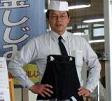Wednesday, May 31, 2006
Yoroi 17

Yoritomo Minamoto established a military family administration in 1192. 140 years are said as the Kamakura Period from 1192. The form of the Heian Period held good in the armor at the beginning of Kamakura shogunate opening. When an administration becomes stable, decoration is pursued with an armor gradually like industrial arts. And, rationality was pursued with an armor from the experience of the actual fighting to the details. The flower of the tree peony and a lion, Fudo-myo-ou, thunder God ,wind God or a dragon and so on was liked in the leather pattern as the characteristics of the Kamakura Period.
Thursday, May 25, 2006
Yoroi 16
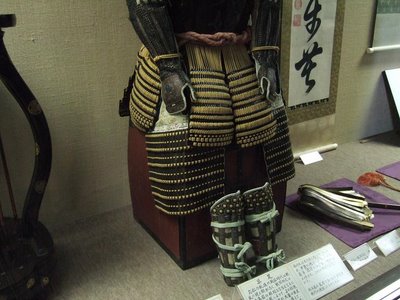
The kote, The suneate, The haidate
The kote covers an arm from the hand. The suneate covers a shin. The haidate covers a thigh. It seems that the haidate was used from about the Nanboku-cho Period. A ieji is surely used for the kote, the suneate and the haidate. Ieji is called Ie-ginu or Odoshi-ginu, too. Silk, cotton, hemp, kinran, donsu, cotton, velvet, woolen cloth, and so on are used for Ieji. A kinran interweaves cloth with the golden yarn, and it is the textile which shows a pattern. A donsu is satin. A chain and hardware or Sane is sewn on the ieji. Hardware is in such cases as the board of the iron called Shino. As for the ieji, the triple structure of the right face, the lining cloth and the foundation is general. But, there is a single, too.
Tuesday, May 23, 2006
Yoroi 15

When it was in the Kamakura Period, the use of the domaru increased gradually. Even the battle to shoot a bow on the horse was easy to use for the domaru. It was practical in case of hand to hand combat by the sword as well. A battle in the urban district. Or, a battle in the inside. The light armor which operated easily was liked in such a place. So, domaru was liked more than heavy the yoroi which didn't operate easily. There was the 2nd attack of the Mongolian army in 1281. It became the collective right of attack by the infantry at that time. The practical use of the domaru was recognized by many people by this battle. And, as for the guerrilla fighting as well, practical use was recognized. An armor was improved like this by the actual fighting. Then, it prevail gradually.
Monday, May 22, 2006
Yoroi 14
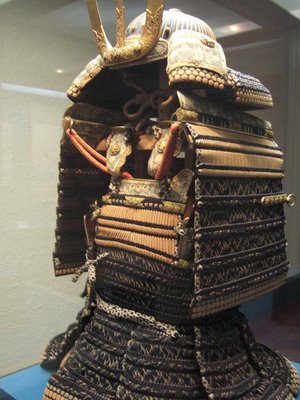
The gyoyo
The gyoyo are two sheets of boards which hang down at the front of the shoulder. An early domaru didn't use the sodes. Instead, an iron board was attached. this is the gyoyo. The gyoyo is the ornament of a cord to put on the head of the horse, the breast and the tail. Because a form looks alike, two sheets of boards of the domaru are called gyoyo, too. In other words, it didn't need to attach sodes to domaru. The sode were attached when it was armed to the teeth. Then, the gyoyo was moved at the front of the shoulder.
Sunday, May 21, 2006
Yoroi 13
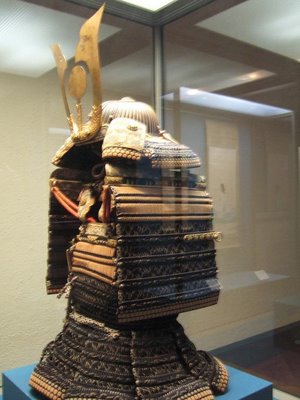
A domaru
There is one more form of the armors which took root in the Heian Period end(12th century). That is a domaru. A domaru was armed to the handy. Then, it was improved by the one for the infantryman. It is attached in the right side. That joint is said as Hikiawase. Then, there is an idea that an infantryman walks easily in the kusazuri. The kusazuri is divided into eight. This is said as Hachiken-kusazuri. This form is a domaru.
As for the infantryman, it was general that the kabuto(the skull), the sode(An upper arm is defended from the shoulder) , the kote(An elbow is covered from the hand) and the suneate(A shin is covered) weren't attached. As another way of using. It was sometimes put on under the clothes in preparation for the unexpected attack. A domaru can be worn easily. So, leaders came to use, too. It was armed to the teeth. The kabuto, the sode, the kote and the suneate were attached to the domaru.
Saturday, May 20, 2006
Yoroi 12
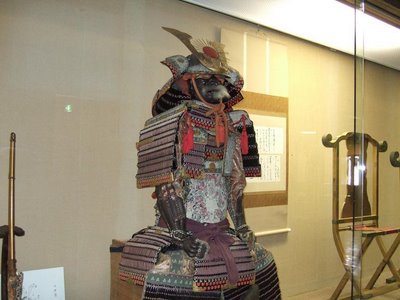
A leader wore an o-yoroi.
It used in the Kamakura Period from the Heian Period end (12th~14th century). The Mongolian army attacked Japan in the Kamakura Period(1274). The Japanese army fought hard at this time. It is because the tactics of the Mongolian army was rational. The Mongolian army was the collective right of attack by the infantry. The Japanese army had to change tactics. That is the collective right of attack by the infantry. An o-yoroi stopped almost being used in the Nanbokutyo Period(1334~1392).
It owns the kozakura-odoshi-yoroi and the kon-ito-odoshi-yoroi in Itsukushima shrine Hiroshima Prefecture. The yoroi of this photograph is displayed in Matsue castle Matsue City Shimane Prefecture .
Friday, May 19, 2006
Yoroi 11
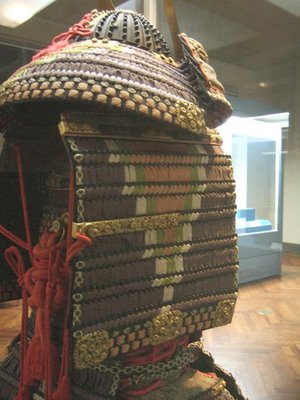
The sode
The name of this yoroi is Murasaki-ito-saka-omodaka-odoshi-no-yoroi. Pay attention to the motif of the sode. The pattern of the sode made the leaf of the omodaka a design.The omodaka is perennial plant. This pattern is made up-down reverse. That is said as Saka in Japanese. Therefore, that is said as Saka-omodaka. Another name of the omodaka is said as Kachi-gusa. That meaning is the plant of the victory. A kuwai for food is the plant of the same kind again. Generals liked the word of the victory. So, a pattern is taken. It hopes for the victory, and the kuwgata is used, too. This pattern was trend in the 13th century from the 12th century. A purple thread is a basis with this yoroi. Therefore, it is called Murasaki-ito-saka-omodaka-odoshi. The sode have the ornament of the suso-kanamono. The flower of the chrysanthemum and a leaf are made a pattern.
Thursday, May 18, 2006
Yoroi 10
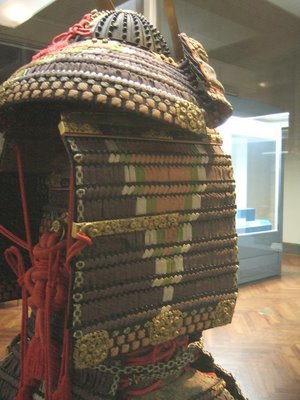
The sode
An arm is defended from the shoulder. The sane is connected with the side with the string. This is said as sane-ita. The sane-ita is connected with the bottom with the odoshi-ge from the top. This technique is called Odoshi. A little shield is made by this technique. This little shield is said as Sode. Metal fittings are being fixed on the part of the back of the yoroi. This is said as Agemaki-tsuke-no-kan. The string of the cross form is connected there. This string is said as Agemaki. The sode are connected with Agemaki by a string. It is to defend the movement of the arm effectively.
Wednesday, May 17, 2006
Yoroi 9

As for the skull, the board called Hagi-ita is joined with a rivet together. The shape of the rivet and size change by the age. There are the ika-boshi, the o-boshi, the arare-boshi, the nuka-boshi, the iga-boshi and so on. A rivet is exaggerated, and it comes to be called Ika-boshi-no-kabuto in the Heian Period middle (11th century).
Ornament in front of the skull is said as kuwagata. It looks like a shape of the hoe. Or, it is said that it is the shape of the plant of a kuwai, too. Early the kuwagata were parallel. It became a type V letter like a leaf of the kuwai from about the Kamakura Period end(14th century). It is fixed on the part which it is called Mabisashi. The part called kuwagata-dai is fixed first. Then, the kuwagata is fixed. It seems that generals liked this form.
Yoroi 8
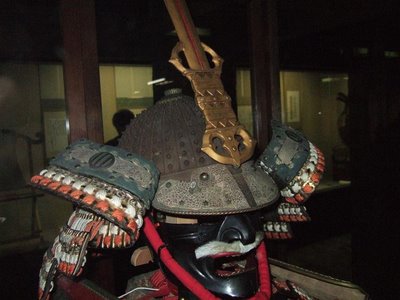
The skull
The skull is equipped with the shikoro. The shikoro defends a warrior's neck. It is composed by the sane. The shikoro grows big toward the bottom. The technology of the odoshi is being used for this, too. Both ends of the shikoro are open in the outside. This is said as fukikaeshi. The leather that a pattern was drawn is mounted that front. Metal for the decoration were fixed on that.This is said as suemon-kanamono. Ornament was put on in front of the skull. This is said as maedate. The leather that a pattern was drawn is said as kawa-dokoro. That pattern has many kinds. That is mounted many parts of the yoroi. Leather is mounted the tsurubashiri, the fukikaeshi, the reverse of the yoroi, the part of the metal for the decoration , and so on.
Monday, May 15, 2006
Yoroi 7
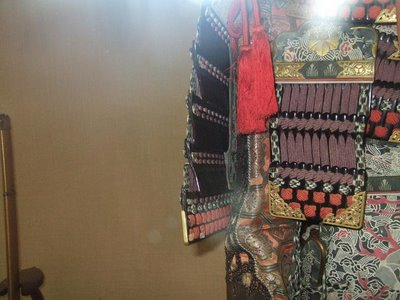
The sendan-no-ita
A knight must sometimes fight with a tachi sword. At that time, he fights against the right enemy. Because, it is difficult to fight against the left enemy. At this time, a gap occurs by the right side. The sendan-no-ita defends a right side gap. The sendan-no-ita is devised so that it may be adapted to a complicated movement to use a tachi sword. A knight has reins with his left hand in case of riding, and a tachi sword is used with the right hand. Because of that, a handle curves with a tachi sword. That is the idea to be easy to cut with a tachi sword. And, the handle of the tachi sword is short to have it with one hand.
Saturday, May 13, 2006
Yoroi 6
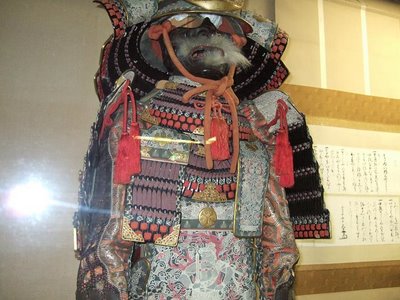
Two sheets of boards defend both sides.
It faces with the left enemy when knight shoots a bow. It is because the string of the bow is pulled with his right hand. At that time, a gap occurs by the left side. This gap is said as the ya-tsubo, and it is a week point. The ya-tsubo is a vital organ, and the enemy aims at the ya-tsubo. The kyubi-no-ita defends a left side gap. That is one sheet of board of the left breast of the photograph.
Thursday, May 11, 2006
Yoroi 5

The power of the bow in those days was weak. Then, the string of the bow couldn't be pulled from the form of the armor strongly. Therefore, a battle was done at point-blank range. The idea to defend an arrow is being given with the yoroi. That one is the Shoji-no-ita. A board is being fixed on both sides of the neck. See a photograph. It is the oval-shaped board of both sides of the string of the skull. This is the Syoji-no-ita. The skull was taken off when the warrior had to pull a bow strongly.
Wednesday, May 10, 2006
Yoroi 4
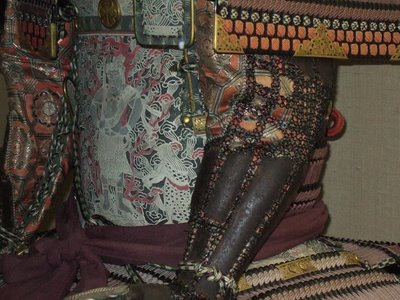
The main weapon of the knight is a bow. Because of that, the improvement to handle a bow on the horse is being given. A yoroi is composed of the sane. The front is covered with leather of the deer because the string of the bow is caught in the sane. This leather is said as Tsurubashiri-gawa. Various patterns are dyed with the turubashiri-gawa. As for that picture, a peony, a lion and the Fudo-myo-o were liked.(This photograph is Fudo-myo-o). The tsurubashiri-gawa are the characteristics of the O-yoroi.
As for the battle in those days, Self-introduction was shouted to each other on certain. Then, a man-to-man fight was done. It became a tussle on the horse if the outcome wasn't settled with a bow. They might fall from the horse. Even if they fell from the horse, the outcome was surely settled. It is desperate, and they win fame as a warrior.
Mitsukane

Tanto Sword
By Mitsukane
Kamakura period, 13th century.
Mitsukane Rai is the pupil of Kunitoshi Rai in Kyoto. He lived in Ominokuni (Shiga Prefecture). It seems that he was making a sword by Enryakuji temple as well. This Tanto descended to the Matsudaira Family in Echizen (Fukui Prefecture).
Tuesday, May 09, 2006
Kunimune
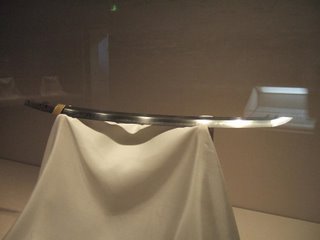
Kodachi Sword
By Kunimune
Kamakura period, 13th century.
A kodachi is a short tachi. It considers that a kodachi was hung like a tachi in the waist. A tachi is hung with the string in the waist. But, as for the use, it isn't clear. As for the length, it looks like a wakizashi. Kunimune was a katana-kaji in Bizen (Okayama Prefecture).
Sunday, May 07, 2006
Uesugi-Tachi

Tachi Sword
Known as Uesugi-Tachi
Ichimonji school
Kamakura period, 13th century.
It belongs to Kamakura middle Bizen (Okayama Prefecture)Ichimonji school. The name of 1 is being carved.It is chojimidare that the pattern is made at the time of quenching. The point is called Kamasu-Kissaki (barracuda-point). this is the introduction goods of the Uesugi Family, and it is called Uesugi-Tachi.
Saturday, May 06, 2006
Yoroi 3
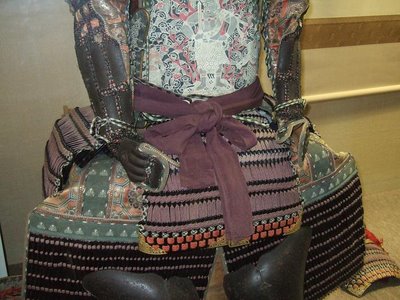
The Heian Period middle, local clan or local officer organized an influential armed farmer, and a samurai group was organized. As for the battle of the Kamakura Period, piggyback fight was the main stream from the Heian Period. The knight was one combat unit. This is said as Ikki. The yoroi defends the whole body of knight. Because of that, a function on the horse was investigated with an armor. A yoroi for the piggyback fight of this age is said as O-yoroi as well with a popular name. The characteristics of this yoroi is the Kusazuri. The kusazuri defends a thigh from the waist. The kusazuri is defended like a box. It is attached on front and back and the right and left. This is said as Yongen-Kusazuri.
Friday, May 05, 2006
Yoroi 2
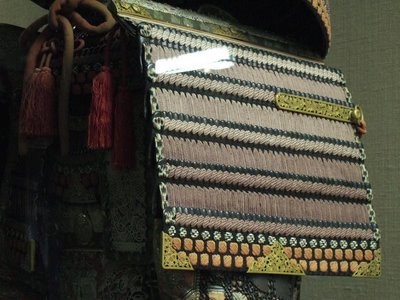
The beginning of Japanese armor
A part of the wooden armor is excavated from the remains of about the Yayoi Period middle(B.C. the fourth century-the 3rd century). The armor of this age is called Tanko. An armor becomes made of the metal in the Kofun Period (3rd century-7th century). The sane comes to be used. Sane is the board of the size which made a calling card half length-ways. The armor of this age is called as Keiko. The sane is connected with the side with the string. And the sane which became one sheet of board-shaped is connected in the bottom from the top with the string. It is said as Odoshi that it is connected by the string. This string is said as Odoshi-ge. The material of Odoshi-ge is in such cases as silk, the cotton, the deerskin and the aya. The aya is the silk thread knitted in the slant line pattern. It is the Heian Period end(12th century) that the form of the Japanese yoroi is completed. The technology of the odoshi makes the beauty of the yoroi.
Thursday, May 04, 2006
Yoroi 1

A Yoroi
So that an armor can protect a body on the occasion of the battle. Such a protector will exist in the world. A purpose is the same with a Japanese Yoroi,too. However, a Yoroi is very beautiful, and it is evaluated high as a work of art. The generals who faced a battle investigated a function in the armor. But,why is it to give a Yoroi a beautiful color and a pattern? When a generals' armor is seen, it feels that they who faced death in the battlefield were looking for beauty seriously. Generals are dressed brilliantly to show off a manly figure. It feel that figure to be brave. It thinks about a life and death at the same time.
Wednesday, May 03, 2006
Norinaga
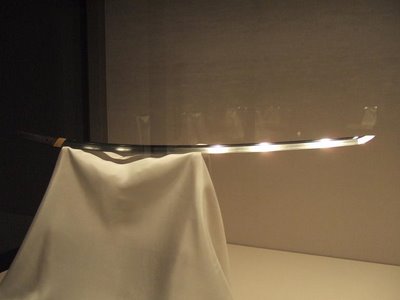
Tachi soword
By Norinaga
Kamakura period, 13th-14th century.
Norinaga is the katana-kaji of the Kamakura Period end. Norinaga belongs to Yamato-Shikkake side. A style looks like Tegai Kanenaga who is a katana-kaji inYamato Tegai side. Meiji Emperor was presented from the Danzan shrine of Nara Prefecture in 1886.
Tuesday, May 02, 2006
Norikuni
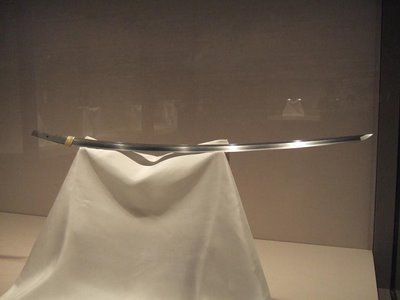
Tachi Sowrd
By Norikuni
Kamakura period, 13th century.
They are the katana-kaji who were active in Awataguchi Kyoto . Kunitomo and five brothers were active in the early stages of the Kamakura Period. It says that Norikuni is Kunitomo's child. He was active in about 1235. There are a few his existent works. Hamon is suguha.
Monday, May 01, 2006
Kunikane

Tachi Sword
By Kunikane
Heian period, 12th century.
A katana-kaji before the Kamakura Period is called Kobizen in Bizen-kaji. Bizen is present Okayama Prefecture. Many katana-kaji existed in Chugoku district because the iron sand of good quality was produced. Tomonari and Masatsune are famous. Then, Kunikane is famous, too. But, there are a few existent swords. The hamon are Komidare and Kochoji.
